Big Pharma Visits the Bayshore
The visit may help protect horseshoe crabs as conservationists urge companies to drop testing method that uses crab blood.
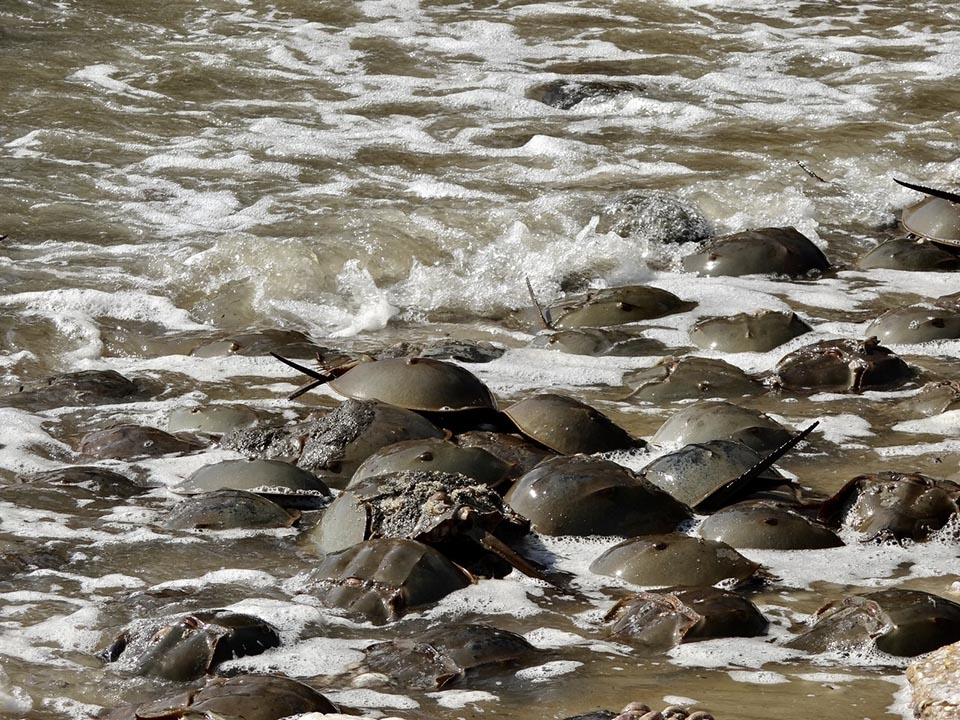
This story is being republished under a special NJ News Commons content-sharing agreement. Link to story: njspotlightnews.org/2024/05/big-pharma-pharmaceutical-companies-meet-delaware-bayshore-consider-synthetic-test-versus-using-horseshoe-crab-blood-tests/
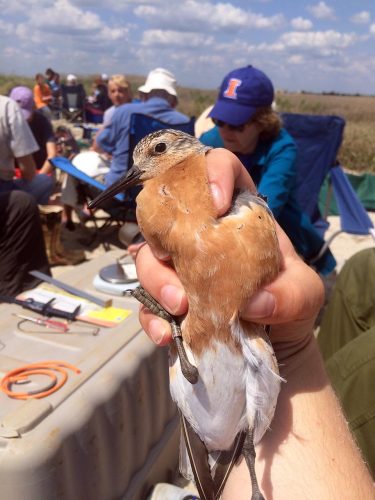
Officials from five major pharmaceutical companies met at a Delaware Bayshore house to hear how they can help save the horseshoe crab and to watch the annual spectacle of spawning horseshoe crabs and migrating shorebirds along a remote part of the New Jersey coastline.
The gathering on May 23, at Reeds Beach, Cape May County, was the first time that pharmaceutical industry officials trekked to the rural bayshore to discuss the arguments for dropping a testing method that uses the blood of horseshoe crabs, and to walk the beaches where the crabs spawn and thousands of birds feast on their eggs for a couple of weeks each spring.
Advocates for the protection of both horseshoe crabs and red knots hope that the combination of chemistry and conservation will persuade the officials to recommend the companies switch from the crab-based LAL reagent most use now to a synthetic substance called rFC when testing for endotoxins in medical products.
An industry-wide switch away from the crab-based reagent would end a significant source of demand for horseshoe crabs. That would give the ancient creatures a better chance of fully recovering from a drastic over-harvest in the late 1990s and early 2000s, when they were taken from bay beaches in huge numbers by the commercial fishing industry, which uses them for bait. The over-harvesting caused the population of red knot, a federally threatened shorebird that depends on the crab eggs, to crash, raising fears the bird would go extinct unless its favorite food source was also protected.
Conservationists see the Big Pharma meeting as their best shot in years at protecting horseshoe crabs which feed other fish and birds as well as the red knot and so are seen as crucial to the ecology of the Delaware Bay. While red knot numbers edged off their lows to 22,000 in 2023, according to an in-person count, they are still nowhere near some 90,000 that visited the bay every year in the 1980s and early ‘90s.
Elizabeth Baker, director of research policy for the Physicians Committee for Responsible Medicine, one of the meeting organizers, said there was “no pushback” from the participants to the idea of switching their testing reagents, and that she expects them to recommend that change to their companies. The event took about six hours, she said.
Making the argument: The meeting was due to be addressed by Jay Bolden, a senior official at the Indianapolis-based Eli Lilly, a major pharmaceutical company that switched to rFC starting in 2016, and now does 80 percent of its testing using the synthetic product. Bolden is also an avid birder and understands the link between shorebirds, horseshoe crabs and the pharmaceutical industry in a way that his peers at other companies may not.
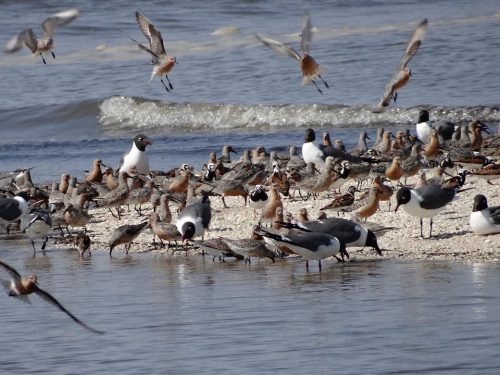
Bolden recalled his first sighting of spawning horseshoe crabs on a beach in Delaware, and understood its link with the biomedical industry.
“All the crabs just came out of the sea, and it really hit home where the reagent in that vial comes from, and the chance that we had to make a positive impact. It was in our control,” he said in an interview at a Cape May hotel before the meeting.
Bolden said he planned to explain the reasons for Lilly’s switch to the synthetic product, which he said is less costly and more reliable than the crab-blood alternative. He also argued that the supply of a lab-based product will always be more reliable than one that depends on harvesting crabs from the ocean. He said the synthetic product the company uses does not deliver false positives, as the crab-based reagent sometimes does.
Although Lilly has done much more to adopt the synthetic product than any other pharmaceutical company, some others are beginning to look at the switch, Bolden said. The Food and Drug Administration has now approved Lilly’s use of rFC for testing nine of its products, he said.
The benefits of switching: In addition to its benefits for wildlife, a reliable synthetic supply of reagent will help pharmaceutical manufacturers be ready for another human pandemic when demand for medicines would spike, Bolden and other conservationists say.
Conservationists supporting the initiative include Dr. Joanna Burger, a distinguished professor of biology at Rutgers University, and an eminent shorebird researcher. “Change can be brought about by one of their own talking about the issues. What he’s doing is incredibly important, and he has a wider picture of the importance of horseshoe crabs in the bay,” she said, referring to Bolden.
The number of horseshoe crabs in Delaware Bay rose to about 40 million males and 16 million females in 2022 from 10 million males and 6 million females between 2003-12, according to the Atlantic States Marine Fisheries Commission, a federal regulator. It issues annual horseshoe crab harvest quotas for bait to all four bay states—Delaware, Maryland, Virginia and New Jersey—and notes that the maximum catch bay-wide would be only 1.3 percent of the latest estimated population of both males and females.
Because of state and federal confidentiality laws, the commission does not disclose data on the number of horseshoe crabs taken from Delaware Bay. But it says the total catch—including those taken for bait—does not exceed the harvest quota set by the commission each year, and that the biomedical catch in the bay doesn’t have a major impact on stocks.
“For the Delaware Bay, biomedical removals have an insignificant impact on the stock at its current levels,” said Tina Berger, a spokeswoman for the commission.
For the 2023 and 2024 fishing seasons, the commission considered allowing the harvest of female horseshoe crabs to resume after a 10-year ban. But it dropped the plan in light of public concern over the fate of the red knot, and there is currently no proposal to restart the female harvest, Berger said.
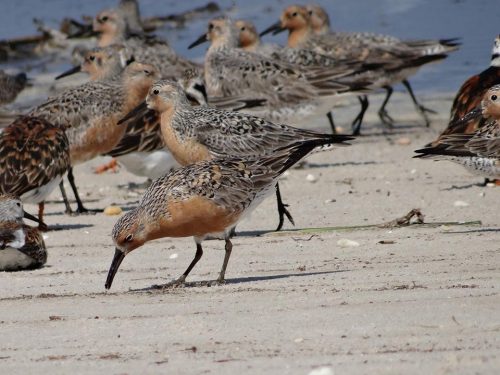
New Jersey banned the harvest of horseshoe crabs for bait with a state law in 2008, but the fishing industry is still allowed to catch undisclosed numbers of the crabs for biomedical bleeding in New Jersey waters.
Investment decisions: The pro-conservation arguments were supported by BNP Paribas, a global investment bank that places a high priority on sustainability in its investment decisions.
“We thought: Let’s bring them to the beach; let’s show them the horseshoe crabs; give them something to make it real,” said Adam Kanzer, head of stewardship for The Americas at BNP Paribas Asset Management, who helped to organize the meeting. “Give us something beyond the lab results. Hopefully, you can show them something really beautiful and fragile and impressive, and hopefully we create some change agents. It will give them an additional motivation to move faster.”
Kanzer said there’s no reason the U.S. industry shouldn’t switch, and the reason it hasn’t done so yet may be because there is simply no requirement to do so. Any switch therefore must be made by individual companies, and he hoped the Cape May meeting would give them the impetus they need to do so.
BNP Paribas invests in pharmaceutical companies, including those set to be represented at the meeting, but is not threatening to withdraw its investment if the participants don’t switch testing reagents, Kanzer said.
“We’re trying to softly encourage; we’re trying to give them good advice. There is a significant risk to public health, and a significant risk to the industry. We just don’t really understand why it’s taking as long as it’s taking. We see a solution, and we’re asking them to grab that,” he said.
Hoping nature would impress: Reporters were not permitted to attend the meeting but Bolden, Kanzer and other proponents of the industry switch previewed their remarks in interviews beforehand. The participating companies were not publicly identified ahead of time.
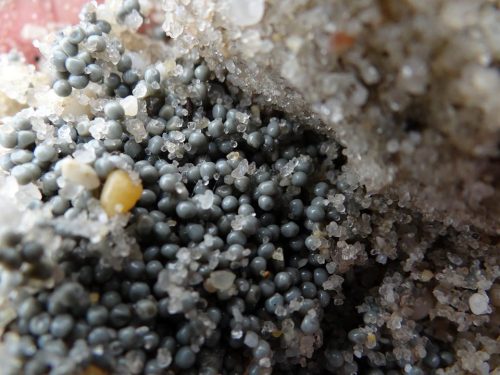
The meeting was held during an annual gathering of conservationists who trap, count, weigh, measure and then release red knots and other imperiled shorebirds that stop briefly on the Delaware Bay beaches each spring before resuming their migration to breeding grounds in Arctic Canada.
The meeting follows a proposal by a trade group that sets scientific standards for the pharmaceutical industry, to recognize rFC as a viable alternative to the crab-based reagent for endotoxin testing. The trade group is expected to finalize its recommendation this fall, but there will be no requirement on pharmaceutical companies to switch, so the Bayshore meeting aims to give participants another reason for doing so.
The nonprofit declined to predict whether the expected finalization of its recommendation would lead the industry as a whole to switch its testing method. “While we cannot predict how industry would respond to standards for recombinant reagents, quality standards are intended to make it easier for industry to develop and produce quality products,” it said in a statement.
In another effort to bolster horseshoe crab numbers in Delaware Bay, conservation groups have asked the National Oceanic and Atmospheric Administration, which oversees marine species, to consider listing horseshoe crabs as endangered or threatened. The agency is expected to say by the end of May whether it will consider a listing.”









